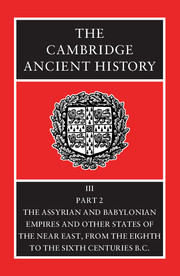Book contents
- Frontmatter
- Contents
- List of maps
- List of text-figures
- Preface
- PART I ASSYRIA AND BABYLONIA
- 21 Babylonia in the shadow of Assyria (747–626 B.C.)
- 22 Assyria: Tiglath-Pileser III to Sargon II (744–705 B.C.)
- 23 Assyria: Sennacherib and Esarhaddon (704–669 B.C.)
- 24 Assyria 668-635 B.C.: the reign of Ashurbanipal
- 25 The fall of Assyria (635–609 B.C.)
- 26 Assyrian civilization
- 27 Babylonia 605–539 B.C.
- 28 The culture of Babylonia
- PART II THE EASTERN MEDITERRANEAN AND THE BLACK SEA
- Chronological Table
- Note on The Calendar
- BIBLIOGRAPHY
- Index
- Map 11: Phoenician and Punic sites in Spain
- Map 13: Scythia
- Map 14: Thrace
- References
27 - Babylonia 605–539 B.C.
from PART I - ASSYRIA AND BABYLONIA
Published online by Cambridge University Press: 28 March 2008
- Frontmatter
- Contents
- List of maps
- List of text-figures
- Preface
- PART I ASSYRIA AND BABYLONIA
- 21 Babylonia in the shadow of Assyria (747–626 B.C.)
- 22 Assyria: Tiglath-Pileser III to Sargon II (744–705 B.C.)
- 23 Assyria: Sennacherib and Esarhaddon (704–669 B.C.)
- 24 Assyria 668-635 B.C.: the reign of Ashurbanipal
- 25 The fall of Assyria (635–609 B.C.)
- 26 Assyrian civilization
- 27 Babylonia 605–539 B.C.
- 28 The culture of Babylonia
- PART II THE EASTERN MEDITERRANEAN AND THE BLACK SEA
- Chronological Table
- Note on The Calendar
- BIBLIOGRAPHY
- Index
- Map 11: Phoenician and Punic sites in Spain
- Map 13: Scythia
- Map 14: Thrace
- References
Summary
THE DEFEAT OF EGYPT
The so-called ‘Chaldaean’ dynasty of Babylon inaugurated by Nabopolassar has also been designated the dynasty of Bit-Yakin or the Third Dynasty of the Sealand. It was not, however, the first occasion the southern tribes had dominated the whole of southern Iraq, for Nebuchadrezzar I, Eriba-Marduk, and Marduk-apla-iddina II had each, for a time, united the leading families against their more powerful northern neighbours. Nabopolassar, aware of the dangers of any lack of central control, followed up the unity shown against their former enemy Assyria with a new alliance with the Medes before taking his army further afield. The treaty arrangements were perhaps intended also to guard the eastern frontier of Babylonia, and were sealed by the marriage of Nabopolassar's eldest son to Amytis of Media. At an early stage Nabopolassar began renovation work on the palace, ziggurat, and walls of Babylon to make the city of Babylon the capital of the newly independent state. His son Nabu-kudurri-usur (Nebuchadrezzar, Biblical Nebuchadnezzar, classical Nabuchodonosor, ‘O Nabu, protect my lineage’) was present at the foundation ceremonies and soon thereafter was proclaimed ‘the chief son, the crown prince’. Since there was no principle of dynastic succession in Babylonia, the king by this means indicated his wish and brought the crown prince into public affairs. They were together in operations near Harran before the king departed from the field, more from the need to have a responsible member of the ruling family in Babylon than necessarily because of the king's ill-health or old age, as Berossus later surmised.
- Type
- Chapter
- Information
- The Cambridge Ancient History , pp. 229 - 251Publisher: Cambridge University PressPrint publication year: 1992

